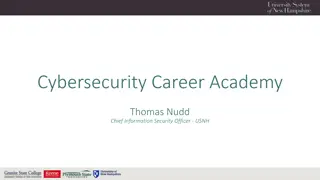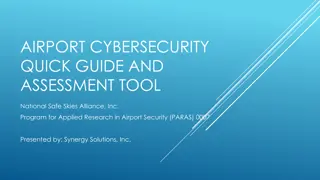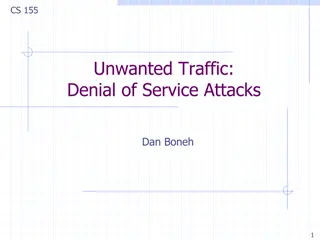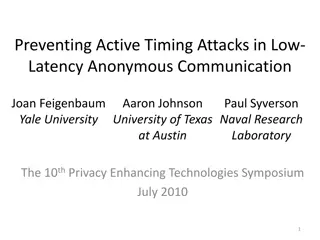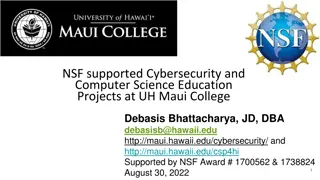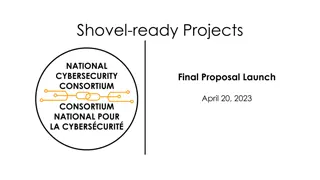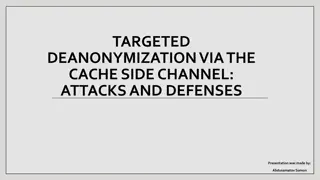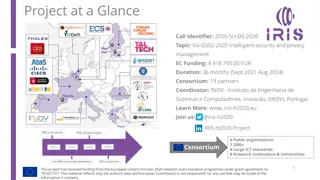
Cybersecurity and Social Engineering Attacks
"Exploring the dangers of social engineering attacks in cybersecurity, including phishing emails, credentials harvesting, and impersonation techniques used to deceive individuals. Learn how technology is not always necessary for these malicious tactics to succeed."
Download Presentation

Please find below an Image/Link to download the presentation.
The content on the website is provided AS IS for your information and personal use only. It may not be sold, licensed, or shared on other websites without obtaining consent from the author. If you encounter any issues during the download, it is possible that the publisher has removed the file from their server.
You are allowed to download the files provided on this website for personal or commercial use, subject to the condition that they are used lawfully. All files are the property of their respective owners.
The content on the website is provided AS IS for your information and personal use only. It may not be sold, licensed, or shared on other websites without obtaining consent from the author.
E N D
Presentation Transcript
Cybersecurity (Security+) and P4 Programmable Switches Social Engineering Attacks Elie Kfoury, Jorge Crichigno University of South Carolina http://ce.sc.edu/cyberinfra Western Academy Support and Training Center (WASTC) University of South Carolina (USC) Energy Sciences Network (ESnet) June 20th, 2023 1
Outline Social engineering attacks definition Social engineering techniques Phishing emails Credentials harvesting Reverse shell 2
Social Engineering Technology is not always needed for attacks on IT Social engineering gathers information by relying on the weaknesses of individuals It relies on the psychological approaches to persuade a victim 3
Social Engineering Technology is not always needed for attacks on IT Social engineering gathers information by relying on the weaknesses of individuals It relies on the psychological approaches to persuade a victim 4 Ciampa, Mark. CompTIA security+ guide to network security fundamentals. Cengage Learning, 2021.
Social Engineering Impersonation Masquerade as a real or fictitious character Play out the role of that person on a victim Impersonated parties include IT support, manager, trusted third party Phishing Sending (millions) email claiming to be from legitimate source Trick user into giving private info: password, credit card number, etc. Variation of phishing attacks Pharming: automatically redirects the user to the fake site Spear phishing: targets only specific users; emails are customized Whaling: spear phishing targeting bigfish, (wealthy individuals) Vishing: Instead of using email, a phone call can be used instead (voice phishing) 5
Phishing Emails Phishing emails are hard to distinguish from legitimate ones Attacker uses logos and colors identical to those provided by a legitimate entity 6 https://www.newcmi.com/blog/tips-for-detecting-a-phishing-email
Credentials Harvesting Gathering sensitive user credentials, such as usernames and passwords, with the intent of unauthorized access to systems or accounts
Credentials Harvesting Gathering sensitive user credentials, such as usernames and passwords, with the intent of unauthorized access to systems or accounts http://216.0.0.10 Host HTML on attacker s server www.facebook.com Clone HTML Attacker 8
Credentials Harvesting Gathering sensitive user credentials, such as usernames and passwords, with the intent of unauthorized access to systems or accounts http://216.0.0.10 Host HTML on attacker s server www.facebook.com Victim Clone HTML Send phishing email containing a link to http://216.0.0.10 Attacker 9
Credentials Harvesting Gathering sensitive user credentials, such as usernames and passwords, with the intent of unauthorized access to systems or accounts http://216.0.0.10 Host HTML on attacker s server www.facebook.com email password Credentials Victim Clone HTML Send phishing email containing a link to http://216.0.0.10 Attacker 10
Credentials Harvesting Gathering sensitive user credentials, such as usernames and passwords, with the intent of unauthorized access to systems or accounts http://216.0.0.10 Host HTML on attacker s server www.facebook.com email Forward password email password Credentials Victim Clone HTML Send phishing email containing a link to http://216.0.0.10 Attacker 11
Credentials Harvesting Gathering sensitive user credentials, such as usernames and passwords, with the intent of unauthorized access to systems or accounts http://216.0.0.10 Host HTML on attacker s server www.facebook.com email Forward password email password Credentials Victim Clone HTML Send phishing email containing a link to http://216.0.0.10 Attacker 12
Reverse Shell Attacker establishes a connection from the victim to their own system Gain full shell access to the victim s machine Create malicious payload / Trojan Attacker 13
Reverse Shell Attacker establishes a connection from the victim to their own system Gain full shell access to the victim s machine Create malicious payload / Trojan Attacker Starts listener 216.0.0.10:4444 14
Reverse Shell Attacker establishes a connection from the victim to their own system Gain full shell access to the victim s machine Create malicious payload / Trojan Send email containing malicious payload Attacker Victim Starts listener 216.0.0.10:4444 15
Reverse Shell Attacker establishes a connection from the victim to their own system Gain full shell access to the victim s machine Create malicious payload / Trojan Send email containing malicious payload Attacker Victim Execute payload Starts listener Reverse TCP shell opened to Attacker s machine 216.0.0.10:4444 16
Reverse Shell Attacker establishes a connection from the victim to their own system Gain full shell access to the victim s machine Create malicious payload / Trojan Send email containing malicious payload Attacker Victim Execute payload Starts listener Reverse TCP shell opened to Attacker s machine Execute remote commands on victim s machine (e.g., install backdoor, keylogger, spyware, etc.) 216.0.0.10:4444 17




